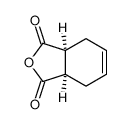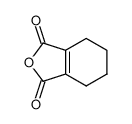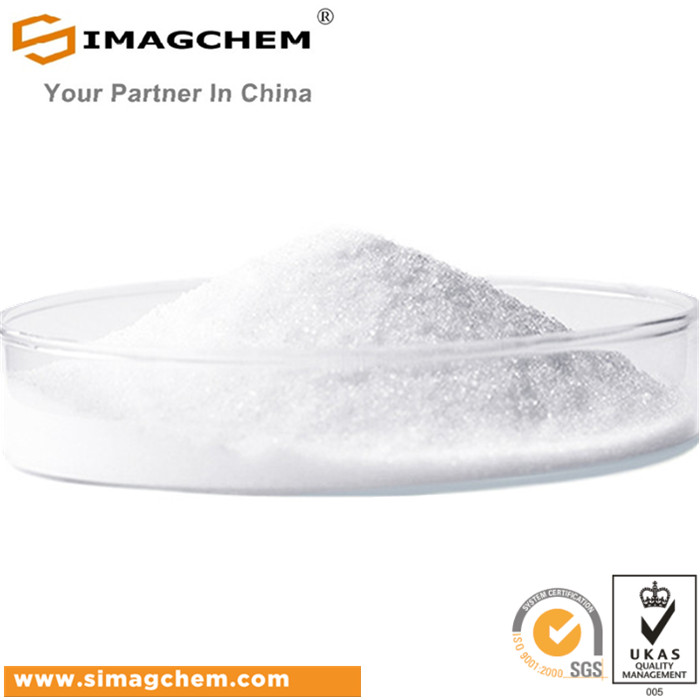1.Identification
1.1 GHS Product identifier
| Product name | Cis-1,2,3,6-Tetrahydrophthalic Anhydride |
|---|
1.2 Other means of identification
| Product number | - |
|---|---|
| Other names | CIS-1,2,3,6-TETRAHYDROPHTHALIC ANHYDRIDE |
1.3 Recommended use of the chemical and restrictions on use
| Identified uses | For industry use only. Intermediates,Paint additives and coating additives not described by other categories |
|---|---|
| Uses advised against | no data available |
1.4 Supplier's details
| Company | MOLBASE (Shanghai) Biotechnology Co., Ltd. |
|---|---|
| Address | Floor 4 & 5, Building 12, No. 1001 North Qinzhou Road, Xuhui District, Shanghai, China |
| Telephone | +86(21)64956998 |
| Fax | +86(21)54365166 |
1.5 Emergency phone number
| Emergency phone number | +86-400-6021-666 |
|---|---|
| Service hours | Monday to Friday, 9am-5pm (Standard time zone: UTC/GMT +8 hours). |
2.Hazard identification
2.1 Classification of the substance or mixture
Serious eye damage, Category 1
Skin sensitization, Category 1
Respiratory sensitization, Category 1
Hazardous to the aquatic environment, long-term (Chronic) - Category Chronic 3
2.2 GHS label elements, including precautionary statements
| Pictogram(s) |   |
|---|---|
| Signal word | Danger |
| Hazard statement(s) | H318 Causes serious eye damage H317 May cause an allergic skin reaction H334 May cause allergy or asthma symptoms or breathing difficulties if inhaled H412 Harmful to aquatic life with long lasting effects |
| Precautionary statement(s) | |
| Prevention | P280 Wear protective gloves/protective clothing/eye protection/face protection. P261 Avoid breathing dust/fume/gas/mist/vapours/spray. P272 Contaminated work clothing should not be allowed out of the workplace. P284 [In case of inadequate ventilation] wear respiratory protection. P273 Avoid release to the environment. |
| Response | P305+P351+P338 IF IN EYES: Rinse cautiously with water for several minutes. Remove contact lenses, if present and easy to do. Continue rinsing. P310 Immediately call a POISON CENTER/doctor/… P302+P352 IF ON SKIN: Wash with plenty of water/... P333+P313 If skin irritation or rash occurs: Get medical advice/attention. P321 Specific treatment (see ... on this label). P362+P364 Take off contaminated clothing and wash it before reuse. P304+P340 IF INHALED: Remove person to fresh air and keep comfortable for breathing. P342+P311 If experiencing respiratory symptoms: Call a POISON CENTER/doctor/... |
| Storage | none |
| Disposal | P501 Dispose of contents/container to ... |
2.3 Other hazards which do not result in classification
none
3.Composition/information on ingredients
3.1 Substances
| Chemical name | Common names and synonyms | CAS number | EC number | Concentration |
|---|---|---|---|---|
| Cis-1,2,3,6-Tetrahydrophthalic Anhydride | Cis-1,2,3,6-Tetrahydrophthalic Anhydride | 85-43-8 | none | 100% |
4.First-aid measures
4.1 Description of necessary first-aid measures
General advice
Consult a physician. Show this safety data sheet to the doctor in attendance.
If inhaled
Fresh air, rest. Half-upright position. Refer for medical attention.
In case of skin contact
Remove contaminated clothes. Rinse skin with plenty of water or shower.
In case of eye contact
First rinse with plenty of water for several minutes (remove contact lenses if easily possible), then refer for medical attention.
If swallowed
Rinse mouth. Do NOT induce vomiting.
4.2 Most important symptoms/effects, acute and delayed
Excerpt from ERG Guide 156 [Substances - Toxic and/or Corrosive (Combustible / Water-Sensitive)]: TOXIC; inhalation, ingestion or contact (skin, eyes) with vapors, dusts or substance may cause severe injury, burns or death. Contact with molten substance may cause severe burns to skin and eyes. Reaction with water or moist air will release toxic, corrosive or flammable gases. Reaction with water may generate much heat that will increase the concentration of fumes in the air. Fire will produce irritating, corrosive and/or toxic gases. Runoff from fire control or dilution water may be corrosive and/or toxic and cause pollution. (ERG, 2016)
4.3 Indication of immediate medical attention and special treatment needed, if necessary
Basic treatment: Establish a patent airway (oropharyngeal or nasopharyngeal airway, if needed). Suction if necessary. Watch for signs of respiratory insufficiency and assist respirations if necessary. Administer oxygen by nonrebreather mask at 10 to 15 L/min. Monitor for pulmonary edema and treat if necessary ... . Monitor for shock and treat if necessary ... . For eye contamination, flush eyes immediately with water. Irrigate each eye continuously with 0.9% saline (NS) during transport ... . Do not use emetics. For ingestion, rinse mouth and administer 5 ml/kg up to 200 ml of water for dilution if the patient can swallow, has a strong gag reflex, and does not drool. Activated charcoal is not effective ... . Do not attempt to neutralize because of exothermic reaction. Cover skin burns with dry, sterile dressings after decontamination ... . /Organic acids and related compounds/
5.Fire-fighting measures
5.1 Extinguishing media
Suitable extinguishing media
Powder, water spray, foam, carbon dioxide.
5.2 Specific hazards arising from the chemical
Excerpt from ERG Guide 156 [Substances - Toxic and/or Corrosive (Combustible / Water-Sensitive)]: Combustible material: may burn but does not ignite readily. Substance will react with water (some violently) releasing flammable, toxic or corrosive gases and runoff. When heated, vapors may form explosive mixtures with air: indoors, outdoors and sewers explosion hazards. Most vapors are heavier than air. They will spread along ground and collect in low or confined areas (sewers, basements, tanks). Vapors may travel to source of ignition and flash back. Contact with metals may evolve flammable hydrogen gas. Containers may explode when heated or if contaminated with water. (ERG, 2016)
5.3 Special protective actions for fire-fighters
Wear self-contained breathing apparatus for firefighting if necessary.
6.Accidental release measures
6.1 Personal precautions, protective equipment and emergency procedures
Use personal protective equipment. Avoid dust formation. Avoid breathing vapours, mist or gas. Ensure adequate ventilation. Evacuate personnel to safe areas. Avoid breathing dust. For personal protection see section 8.
6.2 Environmental precautions
Sweep spilled substance into covered containers. If appropriate, moisten first to prevent dusting. Carefully collect remainder. Then store and dispose of according to local regulations. Do NOT let this chemical enter the environment. Personal protection: P2 filter respirator for harmful particles.
6.3 Methods and materials for containment and cleaning up
Sweep spilled substance into containers; if appropriate, moisten first to prevent dusting. Carefully collect remainder, then remove to safe place. Do NOT let this chemical enter the environment. (Extra personal protection: P2 filter respirator for harmful particles.)
7.Handling and storage
7.1 Precautions for safe handling
Avoid contact with skin and eyes. Avoid formation of dust and aerosols. Avoid exposure - obtain special instructions before use.Provide appropriate exhaust ventilation at places where dust is formed. For precautions see section 2.2.
7.2 Conditions for safe storage, including any incompatibilities
Separated from food and feedstuffs. Dry. Well closed.Separated from food and feedstuffs. Dry. Well closed.
8.Exposure controls/personal protection
8.1 Control parameters
Occupational Exposure limit values
no data available
Biological limit values
no data available
8.2 Appropriate engineering controls
Handle in accordance with good industrial hygiene and safety practice. Wash hands before breaks and at the end of workday.
8.3 Individual protection measures, such as personal protective equipment (PPE)
Eye/face protection
Safety glasses with side-shields conforming to EN166. Use equipment for eye protection tested and approved under appropriate government standards such as NIOSH (US) or EN 166(EU).
Skin protection
Wear impervious clothing. The type of protective equipment must be selected according to the concentration and amount of the dangerous substance at the specific workplace. Handle with gloves. Gloves must be inspected prior to use. Use proper glove removal technique(without touching glove's outer surface) to avoid skin contact with this product. Dispose of contaminated gloves after use in accordance with applicable laws and good laboratory practices. Wash and dry hands. The selected protective gloves have to satisfy the specifications of EU Directive 89/686/EEC and the standard EN 374 derived from it.
Respiratory protection
Wear dust mask when handling large quantities.
Thermal hazards
no data available
9.Physical and chemical properties
| Physical state | WHITE CRYSTALLINE POWDER |
|---|---|
| Colour | White crystalline powder |
| Odour | no data available |
| Melting point/ freezing point | 101-102ºC |
| Boiling point or initial boiling point and boiling range | 195ºC 5mm |
| Flammability | Combustible. |
| Lower and upper explosion limit / flammability limit | no data available |
| Flash point | 157ºC |
| Auto-ignition temperature | 450°C |
| Decomposition temperature | no data available |
| pH | no data available |
| Kinematic viscosity | no data available |
| Solubility | Slightly soluble in petroleum ether and ethyl ether; soluble in benzene |
| Partition coefficient n-octanol/water (log value) | log Kow = 1.96 (est) |
| Vapour pressure | 5.7X10-2 mm Hg at 25°C (est) |
| Density and/or relative density | 1.375 g/cm3 |
| Relative vapour density | (air = 1): 5.3 |
| Particle characteristics | no data available |
10.Stability and reactivity
10.1 Reactivity
no data available
10.2 Chemical stability
Stable under recommended storage conditions.
10.3 Possibility of hazardous reactions
Combustible when exposed to heat of flame.TETRAHYDROPHTHALIC ANHYDRIDE reacts exothermically with water. The reactions are usually slow, but can become violent when local heating accelerates their rate. Acid accelerates the rate of reaction with water. Incompatible with acids, strong oxidizing agents, alcohols, amines, and bases.
10.4 Conditions to avoid
no data available
10.5 Incompatible materials
Reacts with oxidants. Reacts with water to produce heat and tetrahydrophthalic acid.
10.6 Hazardous decomposition products
When heated to decomposition it emits acrid smoke and fumes.
11.Toxicological information
Acute toxicity
- Oral: LD50 Rat oral 5410 mg/kg
- Inhalation: no data available
- Dermal: no data available
Skin corrosion/irritation
no data available
Serious eye damage/irritation
no data available
Respiratory or skin sensitization
no data available
Germ cell mutagenicity
no data available
Carcinogenicity
no data available
Reproductive toxicity
no data available
STOT-single exposure
no data available
STOT-repeated exposure
no data available
Aspiration hazard
no data available
12.Ecological information
12.1 Toxicity
- Toxicity to fish: no data available
- Toxicity to daphnia and other aquatic invertebrates: no data available
- Toxicity to algae: EC50 Scenedesmus subspicatus (algae) 65.7 mg/L/72 hr; Effect: growth rate /Conditions of bioassay not specified in source examined
- Toxicity to microorganisms: no data available
12.2 Persistence and degradability
no data available
12.3 Bioaccumulative potential
Based upon the rapid hydrolysis of structurally analogous phthalic anhydride(1), half-lives of 1.5 and 2.7 minutes(SRC) from rate constants of 6.9X10-3/sec(2) and 4.3X10-3/sec(3), respectively, biococentration of tetrahydrophthalic anhydride is not expected to be an important fate process(SRC).
12.4 Mobility in soil
Based upon the rapid hydrolysis of structurally analogous phthalic anhydride(1), half-lives of 1.5 and 2.7 minutes(SRC) from rate constants of 6.9X10-3/sec(2) and 4.3X10-3/sec(3), respectively, adsorption of tetrahydrophthalic anhydride is not expected to be an important environmental fate process(SRC).
12.5 Other adverse effects
no data available
13.Disposal considerations
13.1 Disposal methods
Product
The material can be disposed of by removal to a licensed chemical destruction plant or by controlled incineration with flue gas scrubbing. Do not contaminate water, foodstuffs, feed or seed by storage or disposal. Do not discharge to sewer systems.
Contaminated packaging
Containers can be triply rinsed (or equivalent) and offered for recycling or reconditioning. Alternatively, the packaging can be punctured to make it unusable for other purposes and then be disposed of in a sanitary landfill. Controlled incineration with flue gas scrubbing is possible for combustible packaging materials.
14.Transport information
14.1 UN Number
| ADR/RID: UN2698 | IMDG: UN2698 | IATA: UN2698 |
14.2 UN Proper Shipping Name
| ADR/RID: TETRAHYDROPHTHALIC ANHYDRIDES with more than 0.05% of maleic anhydride |
| IMDG: TETRAHYDROPHTHALIC ANHYDRIDES with more than 0.05% of maleic anhydride |
| IATA: TETRAHYDROPHTHALIC ANHYDRIDES with more than 0.05% of maleic anhydride |
14.3 Transport hazard class(es)
| ADR/RID: 8 | IMDG: 8 | IATA: 8 |
14.4 Packing group, if applicable
| ADR/RID: III | IMDG: III | IATA: III |
14.5 Environmental hazards
| ADR/RID: no | IMDG: no | IATA: no |
14.6 Special precautions for user
no data available
14.7 Transport in bulk according to Annex II of MARPOL 73/78 and the IBC Code
no data available
15.Regulatory information
15.1 Safety, health and environmental regulations specific for the product in question
| Chemical name | Common names and synonyms | CAS number | EC number |
|---|---|---|---|
| Cis-1,2,3,6-Tetrahydrophthalic Anhydride | Cis-1,2,3,6-Tetrahydrophthalic Anhydride | 85-43-8 | none |
| European Inventory of Existing Commercial Chemical Substances (EINECS) | Listed. | ||
| EC Inventory | Listed. | ||
| United States Toxic Substances Control Act (TSCA) Inventory | Listed. | ||
| China Catalog of Hazardous chemicals 2015 | Not Listed. | ||
| New Zealand Inventory of Chemicals (NZIoC) | Listed. | ||
| Philippines Inventory of Chemicals and Chemical Substances (PICCS) | Listed. | ||
| Vietnam National Chemical Inventory | Not Listed. | ||
| Chinese Chemical Inventory of Existing Chemical Substances (China IECSC) | Listed. | ||
16.Other information
Information on revision
| Creation Date | Aug 18, 2017 |
|---|---|
| Revision Date | Aug 18, 2017 |
Abbreviations and acronyms
- CAS: Chemical Abstracts Service
- ADR: European Agreement concerning the International Carriage of Dangerous Goods by Road
- RID: Regulation concerning the International Carriage of Dangerous Goods by Rail
- IMDG: International Maritime Dangerous Goods
- IATA: International Air Transportation Association
- TWA: Time Weighted Average
- STEL: Short term exposure limit
- LC50: Lethal Concentration 50%
- LD50: Lethal Dose 50%
- EC50: Effective Concentration 50%
References
- IPCS - The International Chemical Safety Cards (ICSC), website: http://www.ilo.org/dyn/icsc/showcard.home
- HSDB - Hazardous Substances Data Bank, website: https://toxnet.nlm.nih.gov/newtoxnet/hsdb.htm
- IARC - International Agency for Research on Cancer, website: http://www.iarc.fr/
- eChemPortal - The Global Portal to Information on Chemical Substances by OECD, website: http://www.echemportal.org/echemportal/index?pageID=0&request_locale=en
- CAMEO Chemicals, website: http://cameochemicals.noaa.gov/search/simple
- ChemIDplus, website: http://chem.sis.nlm.nih.gov/chemidplus/chemidlite.jsp
- ERG - Emergency Response Guidebook by U.S. Department of Transportation, website: http://www.phmsa.dot.gov/hazmat/library/erg
- Germany GESTIS-database on hazard substance, website: http://www.dguv.de/ifa/gestis/gestis-stoffdatenbank/index-2.jsp
- ECHA - European Chemicals Agency, website: https://echa.europa.eu/






















-
-

-
-
-

-
-
-

-
-
-

-
-
-

-
-
-

-
-
-

-
-
-

-
-
-

-
-
-

-
More Suppliers>>Wenzhou Win-Win Chemical Co., Ltd.
CHINA
Purity: 98%
Lead Time: 1 Week(s)
Price: -
Hangzhou J&H Chemical Co., Ltd.
CHINA
Purity: 97%
Lead Time: 2 Day(s)
Price: -
Hangzhou J&H Chemical Co., Ltd.
CHINA
Purity: 98%
Lead Time: 7 Day(s)
Price: -
Xiamen Zhixin Chemical Co., Ltd.
CHINA
Purity: 99%
Lead Time: 3 Day(s)
Price: -
Skyrun Industrial Co., Limited
CHINA
Purity: 99%
Lead Time: 7 Day(s)
Price: -
Puyang Huicheng Electronic Material Co., Ltd
CHINA
Purity: 99%
Lead Time: 1 Week(s)
Price: Min $100 /袋
Henan Coreychem Co.,Ltd
CHINA
Purity: Corey%
Lead Time: 3 Day(s)
Price: -
Shanghai Jizhi Biochemical Technology Co., Ltd.
CHINA
Purity: 99%
Lead Time: 1 Week(s)
Price: -
Hangzhou DayangChem Co., Ltd
CHINA
Purity: 99%
Lead Time: 7 Day(s)
Price: -
Hangzhou Shangjie Chemical Co., Ltd.
CHINA
Purity: 98%
Lead Time: 7 Day(s)
Price: -